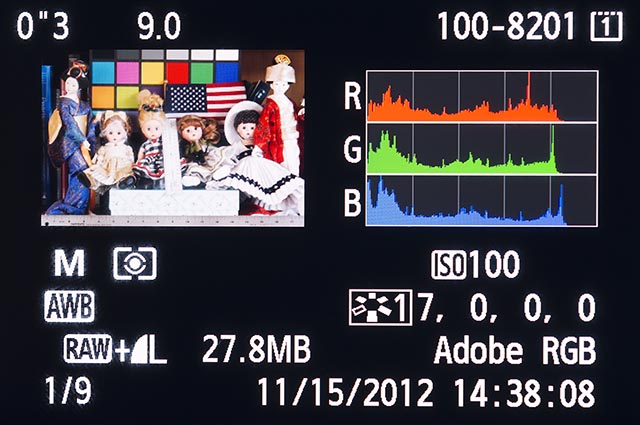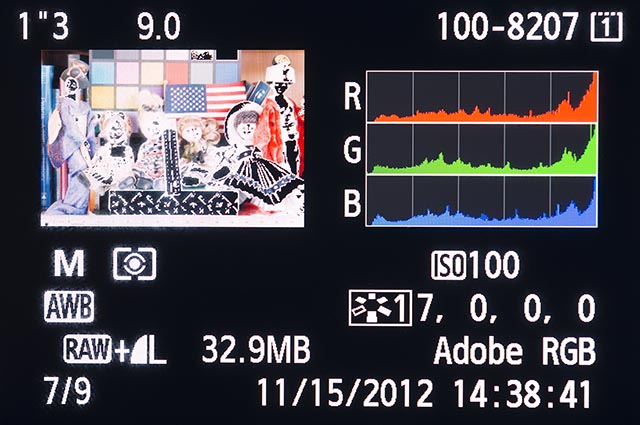A CALL TO ACTION: Build Intelligent ETTR Into Digital Cameras
My recent field shooting and articles prove that Expose to the Right (ETTR) can greatly improve image quality with any camera when shooting RAW, whether it be the Olympus OM-D E-M5, Sony RX100, the Sigma DP1 Merrill, the Nikon D800 or the Canon 5D Mark III— all show major benefits in greatly reduced noise and improved color in dark tones— sometimes shockingly better (compared to the camera’s metered “correct” exposure). RAW required.
The correct exposure for digital is the one that produces the best image quality — the brightest exposure that does not blow-out the highlights (ETTR).
Camera manufacturers don’t “get” this. Most photographers (and even some pro photographers) don’t understand this.
With film, exposure is a rigid relationship: for a precise middle gray (for example), a specific exposure must be selected exactly for that middle gray. This is absolutely not the case for digital (RAW); a wide range of exposure is possible.
The fixed exposure-rendering relationship anachronism should be taken out with the cat litter from both black and white cats.
For the best digital quality with a DSLR or point and shoot— anything with RAW, use ETTR (Expose to the Right).
At present, ETTR is suitable only for RAW (not JPEG) due to flawed camera software, but there is no reason it cannot also be applied to JPEG if only camera vendors would separate the concepts of exposure from rendered image brightness.
Black cats and white cats
What is the correct exposure for each?
- A pure black cat on a pure black background.
- A pure white cat on a pure white background.
A camera meter (film or digital) will record middle-gray cats in both cases. Film or digital.
An incident light meter was always popular for sidestepping this “gray cat” issue by eliminating subject reflectance as a source of error by measuring instead the intensity of the incoming light. This is perfect for film (and JPEG to an extent); blacks render as black, whites renders as white, middle grays render as middle gray.
But for digital RAW, the incident light meter is a severely flawed method for the black cat (or any dark low-key subject). For why this is so, see the ETTR section in DAP.


Should just be automatic
Why should anyone ever have to figure out ETTR manually?
Why should ETTR require (any) knowledge to use?
Those inside a bubble cannot see the bubble.
A century of photographic film photography molded generations of minds that still cannot approach digital as the new technology it is. Hence we see insipidly uncreative “scene modes” for sepia and black and white, but no auto-ETTR. We see new sensor types designed to address noise, but no auto-ETTR. We see noise reduction modes and software, but no auto-ETTR. We see live histograms, but no auto-ETTR. Why beat around the noise bush?
Optimizing Bubble Sort instead of using Heap Sort or Quicksort is stupid. Fix the algorithm, in this case the exposure algorithm.
ETTR and Live View
A camera with Live View already has the data it needs to know exactly how much exposure the sensor can take without blowing out highlights (900K pixels ought to be enough, but presumably most or all of the sensor is available in real time). Many cameras offer a live histogram already, which has to be computed in real time. Connect the dots.
So why isn’t this Live View information being used to offer an auto-ETTR exposure mode?
I don’t see any rocket science here. I don’t want bracketing modes (the shotgun solution with huge penalties in space and time to process), I want the best possible digital capture, as computed by the camera for its statically known capabilities.
Sports/action? Use the exposure mode suitable for the job. But just as low/high shutter sync and low/high auto ISO exist, so too could parameters for auto-ETTR in any auto mode.
Research on ETTR
Search for ETTR at diglloyd.com
Here are a few pages which address this topic in general and specifically. Some of these links are to the referencing blog entries (no login required) and some are to within publications (login required).
- Getting the Best Results From the Olympus E-M5 — ETTR in the Field (Guide to Mirrorless)
- Canon 5D Mark III: ETTR Study of Optimal Exposure for RAW, RAW vs JPEG Exposure Latitude and Sharpness (DAP)
- Expose to the Right (ETTR) (DAP)
- Exposing for Highest Dynamic Range and Lowest Noise (Sony RX100 in Guide to Mirrorless).
- Exposure Bracketing Sequence (Sigma DP1 Merrill in Guide to Mirrorless)
- Dynamic Range Analysis from -2 to +4/3 Stops (Olympus E-M5 in Guide to Mirrorless)
- Pattern Noise — Expose to the Right Analysis (Grill) (Canon 1D X in DAP)
- RAW vs JPEG — Dynamic Range (Fuji X100 in Guide to Mirrorless)
























